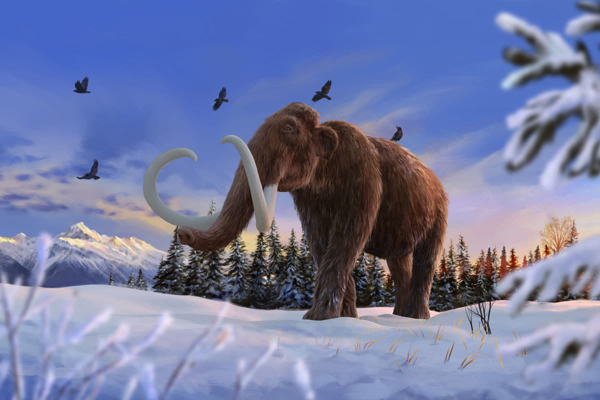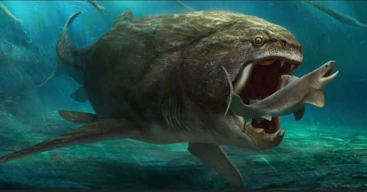Extinct for ages: What made 2024 a memorable year in paleontology?
More than a hundred years after its discovery, the Tyrannosaurus rex (Tyrannosaurus rex) remains a star of paleontology and the "fossil number one." Scientists are constantly intrigued by new details about the dinosaur's life: its skin covering, metabolism, behavior, and familial relationships. Researchers frequently seek out new relatives for it or even attempt to "create" them by dividing the species into parts.
Smart as a Tyrannosaurus
Recently, paleontologists have focused on the brain of the Tyrannosaurus — using computer tomography to study the internal structure of the fossilized skull. This includes a cast of the brain, which, naturally, has left nothing behind except for its shape, now filled with rock. Scientists discovered that the dinosaur possessed a highly developed olfactory center in its brain — indicating it had an excellent sense of smell. They then turned their attention to the intelligence of the T. rex, which led to differing opinions.
An article published in early 2024 thoroughly examined the errors of a previous study, which attributed approximately three billion neurons in the forebrain of T. rex (primarily in the large hemispheres) and, consequently, an intelligence comparable to primates like macaques or baboons. It seems that the idea of an intellectual super predator from the Mesozoic will need to be abandoned.
The new study not only proved that the number of neurons in the Tyrannosaurus' brain could only be around two billion, contradicting previous estimates. The authors noted that there is no reason to believe that the dinosaur's brain was structured similarly to that of modern birds (as the author of the first article had suggested). It is much more likely that the central nervous system of the Tyrannosaurus is closer to that of modern reptiles, which are not particularly bright (for example, crocodiles).
Moreover, even knowing the exact number of nerve cells does not allow us to assign a certain level of intelligence to an animal. This is demonstrated by modern corvids or, say, dolphins (which, according to this logic, should be smarter than humans). Finally, paleontologists also pointed out that a comprehensive approach is necessary when addressing such complex questions. You cannot simply take a bold assumption, transfer knowledge from one group of animals to another, and expect sensational results.
It is essential to consider the evolutionary background of the studied systematic group, its evolutionary path, metabolic rate (luckily, this is now becoming possible), individual organism development, and so on.
So, the question of the intelligence of the Tyrannosaurus seems to have returned to square one. It is unlikely that it was as smart as a macaque; it is more probable that its intelligence was closer to that of a crocodile, but we cannot assert anything definitive at this point.
 9
9 Chromosomes from the Mammoth
The next piece of news relates to mammoths, which are regularly found in the permafrost of Siberia. Strictly speaking, this is not entirely the work of paleontologists, for whom the remains and mummies from more recent ice ages are considered "too young" — they do not qualify as fossils. However, this is undoubtedly a breakthrough in biology and the study of ancient life. It also marks a significant event for global science as a whole.
The center of the sensation was a female woolly mammoth Mammuthus primigenius, discovered in Yakutia in 2018. The carcass was well-preserved thanks to natural "canning" in permafrost, similar to the technology used to make dried and cured meat. In the recent past, people even cooked and ate meat from such frozen carcasses, which speaks volumes about their preservation.
However, the possibility of extracting entire chromosomes from an animal aged about 52,000 years seemed like a fantasy. The condition of that particular mammoth (nicknamed the find) was such that scientists counted its chromosomes (there were 28 pairs) and even reconstructed their three-dimensional shape (conformation) using a newly developed Hi-C method. They were able to describe individual loops of chromatin made of protein and packed DNA measuring 50 nanometers.
How is this possible, and why have other "ice mummies" (of which there are many known) at best preserved only short fragments of DNA? A unique mechanism of "glazing" chromosomes worked: in the conditions of permafrost, they acquired rigidity and immobility, which allowed their shape to remain unchanged. Meanwhile, the ancient chromosomes did not turn into crystals. The author of the study referred to this condition as "chromosteklo," alluding to ordinary window glass, whose molecules behave similarly.
Thanks to this, researchers learned how active individual genes of the woolly mammoth were, meaning they understood how its genome functioned. It suggests that the next step could be the long-awaited "resurrection" of the extinct species. For now, this seems fantastical — the very same fantasy that not long ago was associated with the study of "fossilized chromosomes."
 0
0 What a Fish?
Particularly popular are the largest extinct creatures, especially if they are also predators. Among these gigantic monsters from the past, the Dunkleosteus Dunkleosteus terrelli long held a prominent place — a fish from the Paleozoic group of placoderms, whose head and front body were protected by massive bony plates.
The Dunkleosteus belongs to the order of arthrodires (literally "jointed necks"). Its unique skeletal structure made it "living scissors": its jaws would simultaneously move apart upwards and downwards, quickly creating an area of reduced pressure in its mouth. Water from the outside would rush in — along with prey that the Dunkleosteus would immediately chop with its powerful jaws.
The problem is that only the jaws and the powerful "helmet" at the front typically survive from it and other arthrodires. Thus, paleontologists could only speculate about the structure and size of the rest of its body, using analogies with other fish. It is no surprise that they ultimately "attached" a correspondingly strong body measuring about 10 meters to the impressive head of the Dunkleosteus.
However, recently the Dunkleosteus has been losing its reputation as one of the first truly gigantic super predators. Recent research has shown that it had an disproportionately large head and an overall size of five to eight meters. In 2024, paleontologists utilized a new feature that reliably predicts the total length of a fish — the distance from the front edge of the eye to the back end of the gill cover. Or to the last gill arch in cartilaginous fish, whose gills open on the surface of the body.
According to the new study, the Dunkleosteus was "only" about four meters long or even shorter. This means that its well-adapted predatory head occupied a very large part of its body, unlike modern and well-known extinct sharks.
Meanwhile, the megalodon (Otodus megalodon) — another "terror of the seas" (though from the Cenozoic) — also changed its image this year. Previously, paleontologists doubted that it was closely related to the great white shark (Carcharodon carcharias) and that its appearance could be described merely by scaling up the modern predator. In contrast to the Dunkleosteus, paleontologists now attribute a greater length (about 10 meters) and a narrow elongated body to the megalodon.
 1
1 Did it Have a Spine?
This year also brought exciting finds from the early Cambrian — the time when animals of modern types were emerging. Cambrian deposits yield all sorts of discoveries: various arthropods (including those with unexpected features), common ancestors of seemingly unrelated modern animals, and sometimes something entirely mysterious. Something that is hard to place on the tree of evolution.
However, paleontologists are less fortunate with the ancestors of vertebrates — Cambrian chordates. Currently, the Yunnanozoon, Haikouichthys, Metaspriggina, and a few others are more or less confidently attributed to them. Thus, the article that was published in the summer of 2024 and described Nuucichthys (Nuucichthys rhynchocephalus) seemed particularly valuable.
The authors present it as a soft-bodied vertebrate measuring three centimeters long, with a torpedo-like shape. Its large eyes are closely set at the front, and its body is crossed by numerous transverse blocks of muscle. Unlike other chordates (including contemporaries of Nuucich